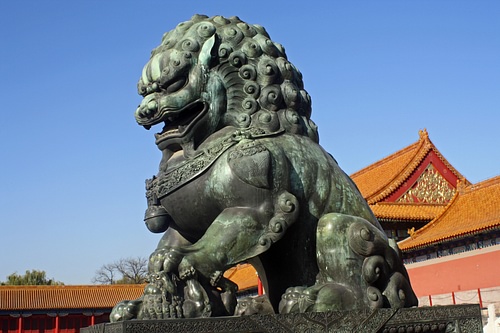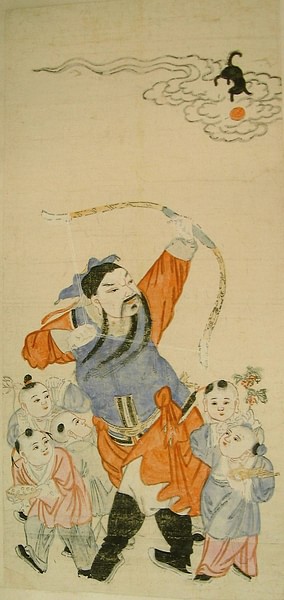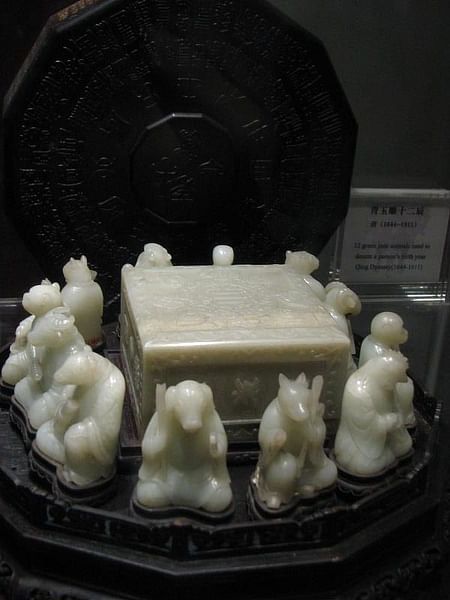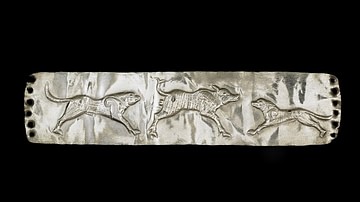Dogs are the oldest domesticated animal in China and were bred as guardians, for transporting goods, for herding, hunting, and as a food source. Archaeological evidence dates the domestication of the dog in China at approximately 15,000 years ago. Remains of dogs have been found in Neolithic graves and their bones in middens dating from the same period onwards.
In ancient China, the dog was always regarded along utilitarian lines as a worker, not as a companion. Even so, dogs were regarded highly not only for their practical uses but as liminal beings who bridged the span between the realms of the living and the dead, the mortal and the unseen world. Chinese folklore often features a dog with transformative qualities or one associated with the divine, and the dog serves as the 11th sign of the Chinese Zodiac.
The famous loyalty of the dog is emphasized not only in folktales and legend but also in art and protective iconography. Jade amulets were often carved in the form of dogs and dog statuary was placed outside of homes, businesses, and royal residences. The dog was recognized early on as a protective force and this image persists to the present day, even though now they are also valued as pets and members of the family.
Early History
The Neolithic site of Banpo Village in Shaanxi Province is one among many offering evidence of the dog's early domestication. The village was occupied between 4500-3750 BCE, and there is no doubt the residents kept many dogs during that time. Dog and pig bones have been found in abundance, and it is possible, even likely, that by this early date dogs were already associated with the spirit world. An image which resembles a dog has been found on ceramic shards along with that of the mythical pig-dragon (precursor to the now famous Chinese dragon and also representing good fortune and protection) suggesting the villagers recognized a spiritually significant aspect of the dog.
Primarily, however, the dog was a functional tool in the everyday life of the village. Scholar Judith M. Treistman writes:
The dog was probably used for food and clothing but most significantly for transportation. In this latter capacity of draft animal, one which was important to later tribesmen as well, the dog was part of the technology of forest efficiency. (31-32)
Although the people of Banpo were primarily vegetarian, they hunted wild game and fished in nearby waters. Treistman notes that the animals hunted included wolf, polecat, mountain sheep, musk, deer, roe deer, wild boar, elk, weasel, and many others. Dogs were used to haul the dead animals back to the village for processing. Once they became too old to assist the hunters, they were most likely killed themselves for their coats and whatever other parts of their bodies could be used.
They were also killed to release their spirit for protection and were buried in front of homes, not only at Banpo but throughout later Chinese history. Ghost stories were the earliest form of literature in China and, as with virtually every ancient culture, the Chinese had a deep-seated fear of ghosts. The most common reason for a haunting was improper burial, and if a ghost appeared, it was usually for either this reason or that the deceased's tomb had been disturbed. There were many different kinds of ghosts, however, and some were simply ill-tempered or disturbed spirits whose interest was in possessing a person or making their lives miserable. Since dogs were recognized as natural protectors, it made sense that they would be especially effective against spirits as spirits themselves.
Dogs as Spiritual Defenders
In time, the practice of sacrificing dogs fell off, and straw dogs were placed before a home or a city's gates for the same purpose, and this observance eventually gave way to statues of lion-dogs, usually made of stone, and known as Foo-Dogs in the west (foo meaning Buddha). This concept originated when Buddhism came to China from India accompanied by the myth that Buddha would ride through the sky on the back of a lion. The Chinese had never seen an actual lion but they had seen the small dog known as the Pekingese. The Pekingese was bred and carefully groomed to look like the descriptions the Chinese had heard of the lion and the Foo-Dog statue, then, came to represent the protective power of the Buddha.
The stone beasts, usually growling and adorned with an ornate belled collar, served the same purpose as the corpse of an actual dog or a straw figure. The bell was thought to warn of the approach of a spirit while the collar was engraved with symbols for protection and, often, the head or face of a spiritual protective entity. They were always placed in pairs; the male has a paw on an ornate ball, representing power and domination over the human affairs of the world while the female has her paw on a wriggling cub, symbolizing control of the forces of nature.
The belled collar motif came from the practice of attaching bells to actual dogs' collars as it was believed that bells (or chimes) would ring in the presence of unseen spirits. The pairing of the Foo-Dogs is also significant in that the female represents the yin force and protects the people of the house while the male represents yang and protects the structure itself.
This exact practice is still observed today in China and elsewhere outside Chinese-owned establishments. One will frequently see lion-dog statues to either side of the door of a Chinese restaurant, and these are there to guard against evil spirits and dark forces. If one pauses to view the statues carefully, one will see that the cub beneath the female's paw appears to be suckling. This detail comes from the ancient belief that lionesses secreted milk through the pads of their paws. The lion-dogs do not resemble lions or dogs so much as mythical creatures from another world, and this, of course, is by design. Dogs were often associated with the in-between realm which separated life and death, which contributed to the high esteem they were held in even as they continued to be used as a source of food.
Dogs in Folklore
Dogs were considered so important, in fact, they were thought to deserve divine protection for their services. One folktale tells the story of a man named Coffin Head Li who was a cruel bully preying on helpless animals, especially dogs and cats. One day, Coffin Head is visited by two men in purple robes who tell him that he has been condemned by the gods of the afterlife for his abuse of animals. Coffin Head laughs their comments off as a joke but they then produce a document detailing the complaints of 460 dogs and cats in the afterlife charging him with cruelty in their deaths.
Coffin Head Li is judged guilty of his crimes and taken away for punishment in the afterlife. This story, like many of the ghost stories of ancient China, served to teach a moral lesson on how one should behave toward others, in this case animals, and the unpleasant fate which awaited one who broke with the kind of behavior expected by the gods.
Treating dogs with respect and remaining true to one's word is one of the morals of the Tale of Panhu. The Chinese ethnic groups of the Yao and She claim the dog Panhu as their ancestor. According to their legends, an emperor named Ku was in conflict with a powerful enemy and promised his daughter in marriage to anyone who could bring him his opponent's head. Panhu the dog accomplished the goal and appeared at the palace with the head and so, however reluctantly, the emperor gave him the princess. The legend concludes with the two of them vanishing into the mountains where Panhu becomes a human prince and he and the princess have many children together.
The transformative nature of the dog is integral to another folktale known as The Lamp Dog. In this story, the steward of a wealthy merchant notices a bright lamp shining above his shelter on his master's property. The light from the lamp seems to slowly descend in a shimmering ball toward the ground where it becomes a dog. The steward rises and follows the dog through the garden where he sees her transform into a beautiful young woman. The steward and the lady spend many nights together until the master hears of this and demands he capture the woman and bring her to him.
The steward does not want to betray his lover but fears his master and so tries to trap her, but she vanishes. Months later, the steward sees his lady as he is coming home from an errand and she leads him to a field of sorghum where a beautiful mansion stands. She tells him their affair is over because of his betrayal but she will give him a farewell party. She prepares him a feast and has many lovely handmaidens wait upon him. When he is done and is returning home, he looks back to see only the field of sorghum.
The lady in the tale is always faithful to the steward, right up until the end when she prepares him the feast, even though he has treated her poorly, just as a dog would behave. The loyalty of the dog and its undeserved mistreatment is at the core of this story as suggested by the woman transforming from a dog.
The loyal dog is featured in many other tales but it is not always seen as a helpful presence. The myth of the Heavenly Dog depicts a dog (known as Tiangou, which literally means 'heavenly dog') which eats the sun or moon during an eclipse and is responsible for childless marriages. Scholar Edward T. C. Werner writes:
The dog is the Dog-star and if the `fate' of the family is under this star there will be no son or the child will be short-lived. Chang Hsien is the patron of child-bearing women and was worshipped by women desirous of offspring. (178)
Chang Hsien is depicted on amulets and portraits from the Sung Dynasty as a bearded man with a raised bow and arrow standing protectively by a young boy. Chang Hsien's job is to shoot the Heavenly Dog before it can cause any trouble. Rituals surrounding Chang Hsien and Tiangou included beating dogs to drive the spirit of Tiangou from a home, and especially so if a couple was trying to conceive a child. Spiritual influence was considered a major factor in conception as, in fact, in every other aspect of life.
Dogs & the Dead
Spirits and the harm they could cause were of great concern to the people of ancient China and remain so today. The belief in ghosts is so prevalent that it even affects the way roads are designed in the country. It is believed that ghosts can only walk in a straight line and so roads are specifically designed to curve and swerve so that certain types of spirits cannot follow one home.
The dog collar also was affected by this belief in ghosts and their manner of travel. Small bells were attached to dog collars, quite common on the collars of the Shih Tzu even today, to scare off spirits. In time, mothers would fasten dog collars to their children with these same kinds of bells to protect them from unseen spirits; a ghost would hear the bells, think the child was a dog, and turn in the other direction. Since a ghost could only walk in a straight line, it was assumed it would not turn back and the child would be safe.
This belief in ghosts stemmed from the understanding that the dead continue to exist after life and are able to help the living (in the form of one's ancestors) or cause harm (as either restless spirits or ones who believe they have been injured or dishonored by the living). Ghosts were potent forces which could easily ruin someone's life if precautions were not taken, and one of the most effective defenses was the dog. Treistman comments on Chinese burial practices and the importance of the dog:
Those who carried the prestige of lineage – and, perhaps at the beginning, those who had acquired special recognition as leaders in raiding and warfare – were buried in large tomb chambers, always accompanied by a dog. (132)
The dog served its master in the afterlife just as it had while on earth by protecting against evil spirits and ghosts. The Chinese afterlife began with the soul crossing a bridge to the other realm where it would either enter heaven to reunite with its ancestors or, if unworthy, drop from the bridge into the abyss of a kind of hell. The dog was thought to go before its master, in some versions of the tale, as both guide and protector. The dog's good nature and loyalty was a comfort on one's final journey although these qualities were also how it almost was excluded as one of the animals of the Chinese zodiac.
The Dog in the Zodiac
The dog is the 11th sign of the Chinese zodiac and among the most popular. According to the story The Great Race, which explains how the zodiac came to be, the Jade Emperor proclaimed there would be a contest and the first twelve animals to cross the finish line would be rewarded with placement in the night sky. Ten animals had already run past the waiting Jade Emperor when the dog finally frolicked by. The Jade Emperor stopped him and asked why he was so late when he always ran so fast. The dog explained that he met friends along the way he had to greet and play with but never lost sight of where he had been called to come.
Another version of the zodiac tale has the dog far off in another country fighting evil spirits and this is what makes him late crossing the finish line. Both versions of the story touch on the nature of the dog as playful, friendly, loyal, and protective. People born under the sign of the dog are considered honest, sincere, loyal, energetic, and intelligent. According to Chinese astrology, their most productive hours are between 7-9 pm (19:00-21:00) and, in the yin-yang dichotomy, they are yang. Their warmth and loyalty attract many friends, and they are usually prosperous and generally happy.
Conclusion
The dog and the long-standing belief in supernatural entities are central to an annual Chinese ceremony known as Tomb Sweeping Day, which falls around the 4th of April during the Qingming Festival. People visit the graves and tombs of their relatives and bring gifts, make sure the graves are cared for, and talk with the dead. Tomb Sweeping Day is not only concerned with the graves of human beings, however, but with one's pets.
The graves of dogs, especially, are honored now during the Qingming Festival, and pet cemeteries have become increasingly popular. From the 1950s through the 1980s it was illegal to even own a dog in Beijing because it was thought a frivolous waste of resources, but the Chinese government has relaxed this stricture, and more and more people in China now own dogs and also spend considerable amounts of money to purchase and maintain their graves once they have passed on.
People visit these cemeteries on Tomb Sweeping Day and leave favorite toys, food, and other objects as presents for their dogs in the same way as for centuries the Chinese have done for their ancestors. The Chinese view of the dog as a resource, rather than companion, would seem to have changed dramatically from ancient times but, as noted, the dog has actually always been more important to the culture than many recognize.









